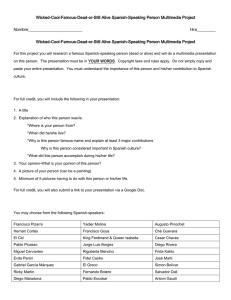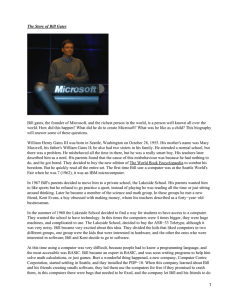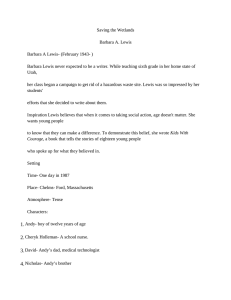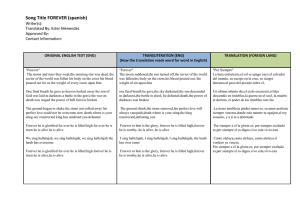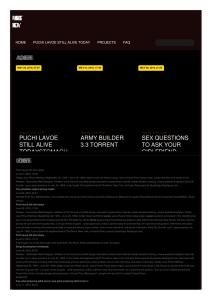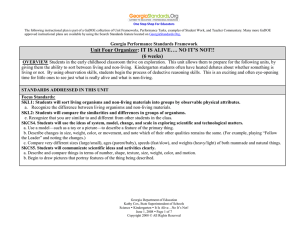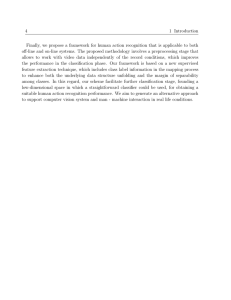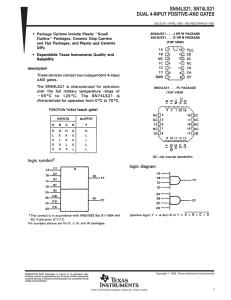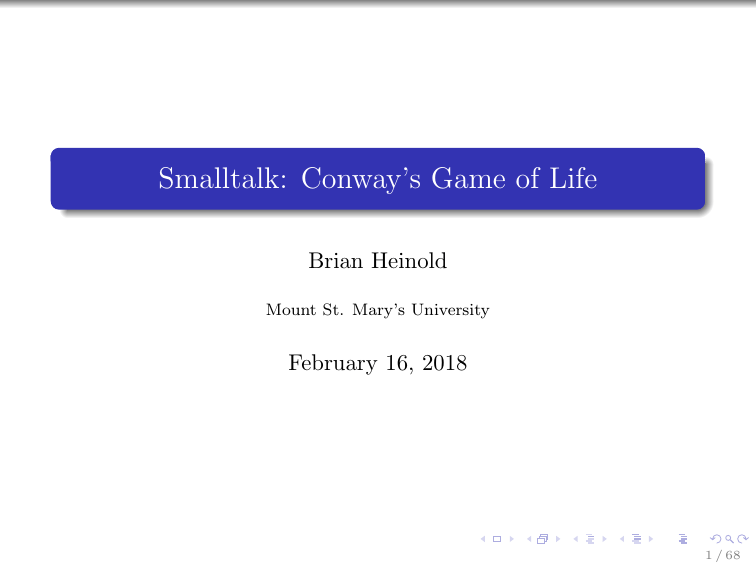
Smalltalk: Conway’s Game of Life Brian Heinold Mount St. Mary’s University February 16, 2018 1 / 68 Board The “game” consists of a grid of cells. Each cell is either on (alive) or off (dead). 2 / 68 Neighbors A cell has 8 neighbors (above, below, left, right, and diagonals). 3 / 68 Rules 4 / 68 Rules 1 Live cells stay alive if 2 or 3 of their neighbors are alive. 5 / 68 Rules 1 Live cells stay alive if 2 or 3 of their neighbors are alive. 2 Live cells with under 2 live neighbors die of loneliness. 6 / 68 Rules 1 Live cells stay alive if 2 or 3 of their neighbors are alive. 2 Live cells with under 2 live neighbors die of loneliness. 3 Live cells with over 3 live neighbors die of overcrowding. 7 / 68 Rules 1 Live cells stay alive if 2 or 3 of their neighbors are alive. 2 Live cells with under 2 live neighbors die of loneliness. 3 Live cells with over 3 live neighbors die of overcrowding. 4 Dead cells come to life if exactly 3 neighbors are alive. 8 / 68 A walk-through — five live cells to start 9 / 68 A walk-through — middle cell dies of overcrowding 10 / 68 A walk-through — the other live cells are okay 11 / 68 A walk-through — four new cells come to life! 12 / 68 A walk-through — the next generation 13 / 68 A walk-through — four cells die of overcrowding 14 / 68 A walk-through — the other live cells are okay 15 / 68 A walk-through — four new cells come to life 16 / 68 A walk-through — the third generation 17 / 68 Another walk-through 18 / 68 Another walk-through — outside cells die of loneliness 19 / 68 Another walk-through — middle cell is okay 20 / 68 Another walk-through — two new cells come to life 21 / 68 Another walk-through — the next generation 22 / 68 Another walk-through — outside cells die of loneliness 23 / 68 Another walk-through — middle cell is okay 24 / 68 Another walk-through — two new cells come to life 25 / 68 Another walk-through — back where we started! 26 / 68 Oscillating patterns Blinker Toad Beacon 27 / 68 Demonstration Throughout this talk, I’ll be switching back and forth between slides and demonstrations. If you want to try it out for yourself, an online app is here: https://brianheinold.net/life.html 28 / 68 More oscillators Pulsar (period 3): Pentadecathlon (period 15) 29 / 68 Even more oscillators From http://www.conwaylife.com/wiki/Oscillator 30 / 68 A still life This is stable. It will not change unless something affects it from outside. 31 / 68 A still life This is stable. It will not change unless something affects it from outside. Every live cell has 3 live neighbors; every dead cell has 2 live neighbors. 32 / 68 More still lifes Tub Beehive Lake 2 33 / 68 More still lifes From http://www.conwaylife.com/wiki/Still_life 34 / 68 Glider This pattern “glides”. It oscillates, but moves as it oscillates. It is extremely important. 35 / 68 Glider moving 36 / 68 Glider moving 37 / 68 Glider moving 38 / 68 Glider moving 39 / 68 Glider moving 40 / 68 Glider gun This pattern generates gliders. 41 / 68 Glider gun This pattern generates gliders. It shows that infinite growth is possible (starting from a finite number of cells, it is possible to generate an unlimited amount). 42 / 68 Other gliding patterns There are various other types of gliding patterns, like this one, called a lightweight spaceship: 43 / 68 R-Pentomino The R-Pentomino below is an example of a “Methuselah pattern”. 44 / 68 R-Pentomino The R-Pentomino below is an example of a “Methuselah pattern”. The terminology comes from the fact that it takes a long time before it settles into a steady-state (1103 generations). 45 / 68 History Invented by John Horton Conway in late 1960s. 46 / 68 History Invented by John Horton Conway in late 1960s. Some fun things he is known for from his Wikipedia entry: Surreal numbers, Monstrous moonshine, Doomsday algorithm, Look-and-say sequence, Icosians, Free will theorem. 47 / 68 History, continued Initially the game was run by hand on tables with counter pieces and necklace shells in the University of Cambridge math common room. 48 / 68 History, continued Initially the game was run by hand on tables with counter pieces and necklace shells in the University of Cambridge math common room. Article published in Martin Gardner’s Scientific American column about it in 1970. 49 / 68 History, continued Initially the game was run by hand on tables with counter pieces and necklace shells in the University of Cambridge math common room. Article published in Martin Gardner’s Scientific American column about it in 1970. After that, it really took off, with people all over writing computer programs for it. 50 / 68 History, continued Initially the game was run by hand on tables with counter pieces and necklace shells in the University of Cambridge math common room. Article published in Martin Gardner’s Scientific American column about it in 1970. After that, it really took off, with people all over writing computer programs for it. Various papers and were written, informal journals created, and 50 years later people are still discovering new things about it. 51 / 68 A one-line program for the Game of Life From the Wikipedia page on the APL programming language 52 / 68 A one-line program for the Game of Life From the Wikipedia page on the APL programming language More reasonably, most Mount CS majors could probably write a Game of Life program in no more than a few hours in their favorite programming language. 53 / 68 Starting with a random board It’s fun to start with a random board and see what evolves. 54 / 68 Putting glider guns together If you put place glider guns in the right locations you can get interesting effects, like these gliders that cancel each other out. 55 / 68 Blocking a glider gun You can also block a glider gun. 56 / 68 Logic gates Putting these two ideas together, you can build logic gates, like this AND gate: 57 / 68 Logic gates Putting these two ideas together, you can build logic gates, like this AND gate: Removing either or both of the two blockers will cause the gliders from A or B to wipe out the glider stream from the source. 58 / 68 Creating a computer We can build logic gates. 59 / 68 Creating a computer We can build logic gates. We can also use these ideas to build things that remember state (memory). 60 / 68 Creating a computer We can build logic gates. We can also use these ideas to build things that remember state (memory). Put all this together, and we can build an actual working computer in Life: https://youtu.be/8unMqSp0bFY 61 / 68 Life can solve anything a computer can So in theory, Life can do anything that a computer can do 62 / 68 Life can solve anything a computer can So in theory, Life can do anything that a computer can do(such as a program to play the Milton Bradley board game) 63 / 68 Life can solve anything a computer can So in theory, Life can do anything that a computer can do(such as a program to play the Milton Bradley board game) In computer science, people say that Life is Turing Complete. 64 / 68 Generalizations Fun to change around the rules for when cells turn on and off and see how things change. 65 / 68 Generalizations Fun to change around the rules for when cells turn on and off and see how things change. Life is an example of a cellular automaton. 66 / 68 Generalizations Fun to change around the rules for when cells turn on and off and see how things change. Life is an example of a cellular automaton. Cellular automata serve as models for physical phenomena like crystallization 67 / 68 Generalizations Fun to change around the rules for when cells turn on and off and see how things change. Life is an example of a cellular automaton. Cellular automata serve as models for physical phenomena like crystallization They are used in simulations of things like traffic flow, spread of a disease, spread of information, and much more. 68 / 68 More demonstrations In whatever time we have left, let’s look at some more demonstrations. Image credits: John Conway: By “Thane Plambeck” – https://www.flickr.com/photos/thane/20366806/, CC BY 2.0, https://commons.wikimedia.org/w/index.php?curid=13076802 Life board game: enjoyingthegameoflife.blogspot.com 69 / 68
